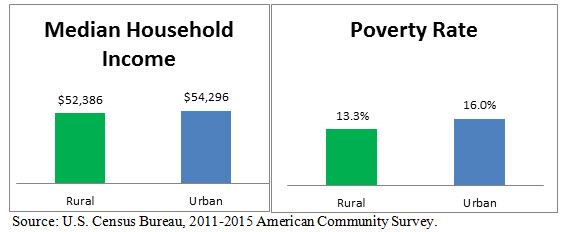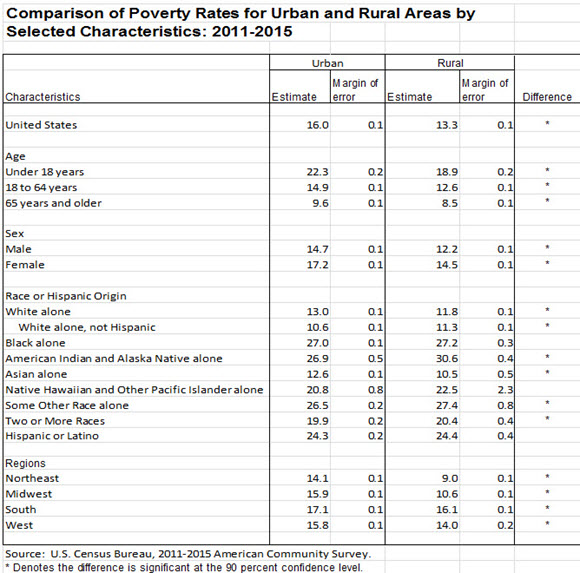A Comparison of Rural and Urban America: Household Income and Poverty
A Comparison of Rural and Urban America: Household Income and Poverty
The U.S. Census Bureau today released data that show that nationally, rural Americans have lower median household incomes than urban households, but people living in rural areas have lower poverty rates than their urban counterparts. According to the 2015 American Community Survey, median household income for rural households was $52,386, about 4.0 percent lower than the median for urban households, $54,296. About 13.3 percent of people in rural areas lived in families with incomes below the official poverty thresholds. The poverty rate for people in urban areas was 16.0 percent. Income inequality, as measured by the Gini index, was lower for rural households than urban households.
However, when we look at specific demographic groups, regions and states, the story is more complex.
Median incomes for rural households in the Northeast ($62,291) and Midwest ($55,704) were higher than their urban counterparts, $60,655 and $51,266, respectively. On the other hand, median incomes for urban households in the South and West were higher. Rural households in the South had a median household income of $46,891 compared to $50,989 for those living in urban areas. For households in the West, rural median household income was $56,061, lower than the $58,545 median for urban households.
Across all four regions, poverty rates were consistently lower for those living in rural areas than for those living in urban areas, with the largest differences in the Midwest and Northeast.
Among the states, 42 had higher poverty rates among people living in urban areas than those living in rural areas. Conversely, in seven states, people in rural areas had higher poverty rates. In one state (South Dakota), poverty rates for urban and rural residents were not statistically different from each other.
In 32 states, median household income was higher for rural households than for urban households. In Rhode Island, for example, median household income for rural areas ($85,278) was about 57 percent higher than the median for urban households ($54,324). In 14 states, the opposite was the case. Median income for urban households was higher than for rural households. In four states, Minnesota, Delaware, Florida and West Virginia, the differences in the median household incomes were not statistically significant.
Rural median household incomes in Connecticut ($93,382) and New Jersey ($92,972) were the highest in the nation. The difference between rural median household incomes in Connecticut and New Jersey was not statistically significant.
Rural median household income in Mississippi ($40,200) was the lowest.
For rural areas, the poverty rates varied from the lowest (4.6 percent) in Connecticut to the highest (21.9 percent) in New Mexico. Poverty rates for the urban areas ranged from the lowest (8.7 percent) in Alaska to the highest (24.9 percent) in Mississippi.
Across all major age groups (children under age 18, for people ages 18 to 64 and for people age 65 and older) and both sexes, poverty rates for people living in urban areas were higher than for people living in rural areas.
Interestingly, households headed by younger householders had higher median household incomes in rural areas whereas households headed by older householders had higher income in urban areas.
- Rural households with a householder under age 25 had a median household income of $31,042. Their urban counterparts had a median household income of $25,656.
- Similarly, rural households with a householder ages 25 to 44 had a median household income of $59,328 versus $58,915 for those in urban areas.
- Households with householders ages 45 to 64 had a higher median household income in urban areas than rural areas, $66,399 and $62,169, respectively.
- The same was true for those households with a householder age 65 and over, $39,202 in urban areas and $37,310 in rural areas.
American Indian and Alaska Natives living in rural areas had higher poverty rates than their counterparts in urban areas, while for whites and Asians, rural poverty rates were lower than urban poverty rates. On the other hand, non-Hispanic whites living in rural areas had higher poverty rates than those living in urban areas. Poverty rates in rural and urban areas were not statistically different from each other for black/African Americans and Native Hawaiians and Other Pacific Islanders. Hispanics, who can be of any race, also had poverty rates for urban and rural areas that were not statistically different from each other.
Median household income was higher for the urban population across all race groups except Asians. There was no statistical difference in median household income in urban and rural areas for Asian householders.
Income inequality as measured by the Gini index for rural households was lower than the Gini index for urban households in 36 states, indicating less income inequality. In only six states, income inequality was greater for rural households than for urban households: Alaska, Arizona, California, Colorado, Hawaii and New Mexico. In eight states, the differences in the Gini indexes were not statistically significant.
For more information about how the U.S. Census Bureau defines urban and rural geographies, see the Rurality Matters blog.









